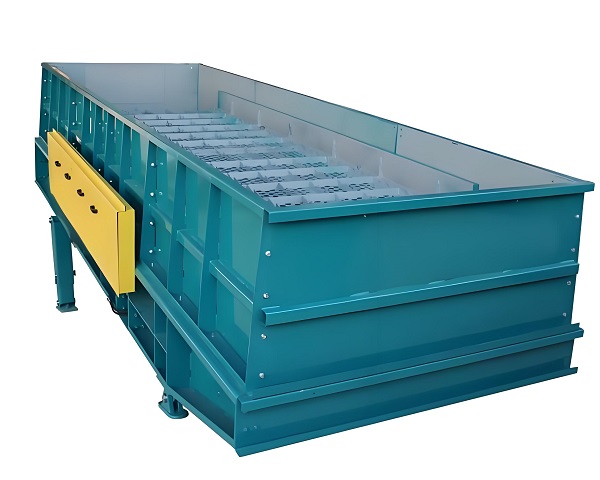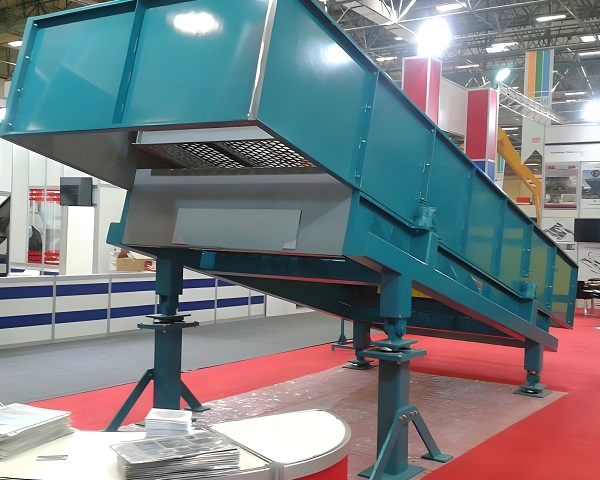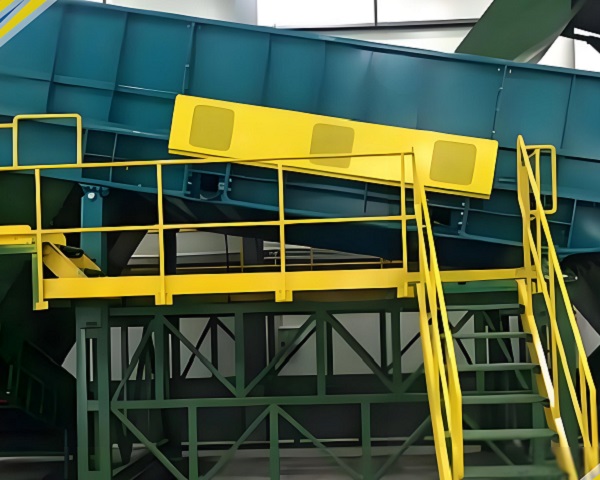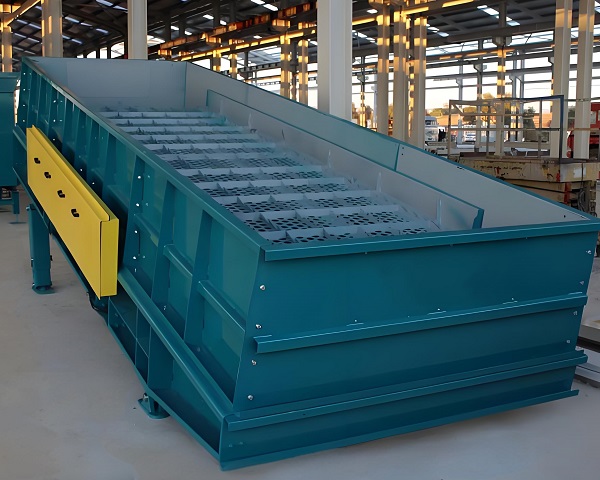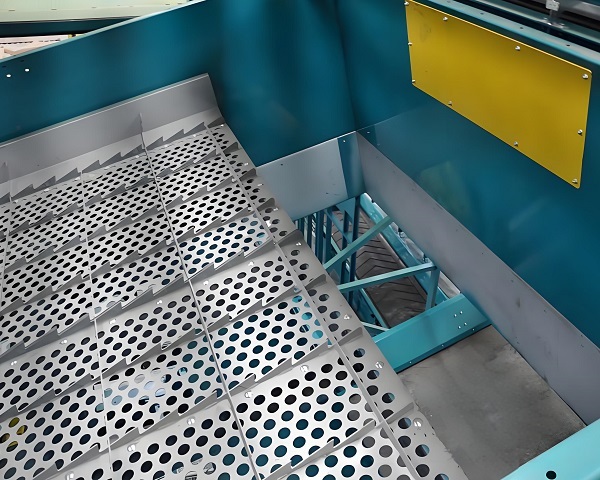A Trommel Screen is a rotary drum screening machine widely used in waste processing, mining, and construction industries. It efficiently separates materials by ......
What is the Ballistic Separator
Ballistic Separator is an important sorting equipment used in the field of solid waste treatment. Its design principle is based on the "ballistic difference" of different materials during vibration and projection, that is, the difference in the movement path of the materials when they are thrown. The equipment uses the rapid reciprocating motion of a set of inclined vibrating screen plates, and utilizes the differences in material form (flat/soft/light vs round/hard/heavy) and gravity behavior to achieve three-way efficient separation of "flat objects", "rolling objects" and "fine materials" in mixed garbage.
The core of the ballistic separator lies in its multiple oblique screen plates, which can reciprocate back and forth at a high frequency (usually 200-300 times/minute), causing the garbage to be constantly thrown and rolled on the screen plates. Due to the differences in structure and quality of various materials, different "bouncing trajectories" are formed: flat and light materials such as plastic film and paper usually slide downward on the upper surface of the screen plate; while harder rolling materials such as plastic bottles, beverage cans, and glass bottles bounce upward; and smaller fragments (such as dust, glass fragments, organic residues, etc.) fall directly through the screen gap. In this way, the equipment can complete the efficient and automatic sorting of three materials at one time.
Ballistic Separator is widely used in the treatment systems of municipal domestic waste (MSW), packaging waste, construction and decoration waste, industrial waste, etc. It is particularly suitable for the pretreatment section before the photoelectric identification equipment, which can significantly improve the working efficiency and accuracy of subsequent equipment (such as near-infrared sorting machine, manual sorting table, etc.). Because its sorting process does not rely on air, magnetic force or photoelectric identification, it has obvious advantages in energy consumption, reliability and stability.
Ballistic sorting machines usually have the characteristics of modular screen plates, adjustable inclination angles and variable frequency drives, which are convenient for flexible adjustment of operating parameters according to different material conditions. At the same time, the equipment has low maintenance, strong wear resistance of the screen plate, low operating noise, and is suitable for continuous high-intensity working environments.
Ballistic Separator is one of the indispensable intelligent screening equipment in the modern solid waste resource treatment system. It has outstanding advantages such as high sorting efficiency, wide adaptability, reliable structure, low energy consumption and long service life. With the continuous development of the garbage sorting and resource recycling industry, the application scope and market demand of ballistic separators are rapidly expanding, becoming an important equipment to promote the automation of intelligent garbage sorting.
Operating principle of Ballistic Separator
Ballistic Separator is an efficient sorting equipment widely used in the field of solid waste treatment. It is mainly used to classify materials in mixed garbage according to physical characteristics, such as rigid/rolling objects, flexible/flat objects and fine particles. Its working principle is based on the different movement behaviors ("bouncing" trajectories) of materials on vibrating inclined screen plates, thereby realizing mechanical automatic sorting.
The ballistic separator consists of multiple inclined, reciprocating screen plates, which generally have an ascending angle of 15°\~25° and are equipped with a forced vibration device to reciprocate at a specific frequency (usually 200-400 times/minute). When the mixed material is evenly thrown onto the screen surface, different forms of materials will respond differently according to their own texture, weight and shape, and thus be separated along different trajectories.
1. Flexible/flat materials** (such as plastic film, paper, cloth, etc.) will maintain more contact with the screen surface due to their light weight and large surface area, slide along the inclined surface of the screen and move forward, and finally be discharged from the "flat material outlet" at the front end;
2. Rigid/rolling materials** (such as plastic bottles, metal cans, glass bottles, etc.) are more likely to be thrown up and roll backward along the screen during vibration, so they are discharged from the "rolling material outlet" at the rear;
3. Fine materials** (such as soil, gravel, organic residues, etc.) can fall directly through the gaps between the screens due to their small particle size and be discharged from the "fine material outlet" at the bottom.
This sorting method based on the difference in motion trajectories has the advantages of simple structure, low energy consumption and high screening efficiency. Unlike traditional air separation or gravity sorting, ballistic sorting does not rely on wind, magnetism or complex sensor systems, and can complete the accurate classification of three types of materials only through mechanical vibration.
Ballistic separators are usually equipped with frequency converters and angle adjustment devices, which can flexibly adjust the screening parameters according to the moisture content, particle size and composition of different materials to further improve the sorting effect. This equipment is suitable for a variety of solid waste treatment scenarios such as urban domestic waste, packaging waste, industrial waste, and construction waste. It is often used as a pre-treatment equipment for optical sorters, wind sorters, manual sorting and other process links to provide uniform and high-quality raw material flow for subsequent fine sorting.
Ballistic Separator uses the three-stage physical behavior principle of "bouncing + sliding + perforation" to accurately realize the three-way sorting of solid waste, playing a key role in solid waste resource utilization and garbage automated sorting systems.
Advantages and features of Ballistic Separator
Ballistic Separator is a highly efficient mechanical sorting equipment widely used in solid waste treatment and resource recovery systems. It is particularly suitable for the pretreatment and sorting of mixed materials such as domestic waste, packaging waste, and construction waste. Its core principle is to use the difference in the bouncing characteristics of materials under mechanical motion to grade and screen garbage of different forms (flat, rolling, and finely crushed).
The biggest feature of the ballistic separator is its versatility and sorting accuracy. The equipment consists of multiple dynamic sieve plates with adjustable inclination angles. These sieve plates will reciprocate at a certain frequency, causing the material to be constantly thrown, slid, or rolled on its surface. By designing different sieve gap sizes and vibration amplitudes, Ballistic Separator can divide garbage into three categories: one is "two-dimensional materials", such as flat and light objects such as plastic film and paper; the second is "three-dimensional materials", such as rigid rolling objects such as bottles, cans, and hard plastics; the third is "finely crushed materials", such as soil, broken glass, small organic matter, etc., which will fall directly from the gaps in the sieve plates.
In terms of performance advantages, Ballistic Separator has the following points:
1. Efficient three-way sorting: Compared with traditional screening equipment, it can separate three types of materials in one step, greatly improving the system efficiency and the working accuracy of subsequent sorting equipment.
2. Strong adaptability: It has stable performance for humidity and sticky materials, and is particularly suitable for processing household garbage and light industrial solid waste with complex components, and can adapt to various processing volume requirements.
3. Simple structure and low energy consumption: The operation of the equipment mainly relies on mechanical vibration and gravity, and does not require compressed air or high-energy consumption sensor systems, with low operating costs and easy maintenance.
4. Strong stability: The modular design is easy to install and maintain, the sieve plate can be replaced, the transmission system design is reliable, and it supports 24-hour continuous operation.
5. Excellent environmental protection: less dust and low noise during operation, and a closed cover can be installed to meet environmental protection standards.
Ballistic Separator is usually used as a mid-to-front-end sorting equipment in conjunction with optical separators, air separators, magnetic separators, etc., which can significantly improve the efficiency and purity of the entire waste resource processing line. It plays an important role in waste incineration, renewable resource recovery, RDF fuel preparation, organic matter separation and other processes. With its high efficiency, stability, energy saving and environmental protection, Ballistic Separator is becoming an indispensable sorting tool in modern intelligent solid waste treatment systems.
Technical Parameter Table of Ballistic Separator
| Model | Number of Paddles | Paddle Length (mm) | Number of Fractions | Inclination Angle (°) | Capacity (t/h) | Motor Power (kW) | Dimensions (mm) |
|---|---|---|---|---|---|---|---|
| BSEP1200 | 4 | 1200 | 3 (2D, 3D, fines) | 12–20 | 8–15 | 5.5 | 4200 × 1800 × 2000 |
| BSEP1600 | 5 | 1600 | 3 | 12–20 | 12–20 | 7.5 | 4800 × 2000 × 2200 |
| BSEP2000 | 6 | 2000 | 3 | 12–20 | 18–30 | 11 | 5400 × 2200 × 2400 |
| BSEP2400 | 7 | 2400 | 3 | 12–20 | 25–40 | 15 | 6000 × 2500 × 2600 |
| BSEP3000 | 8 | 3000 | 3 | 12–20 | 35–50 | 18.5 | 6600 × 2800 × 2800 |
If you have any special requirements, we will customize according to your special needs.
Product Picture Display of Ballistic Separator
FAQ about Ballistic Separator
>1. Is the screen plate of Ballistic Separator easy to damage?
Under normal use conditions, the screen plate has a long life, and is mostly made of high-strength steel or composite materials with strong wear resistance. In case of large particles and hard objects, regular inspections can be carried out to prevent abnormal wear.
>2. What is the environmental performance of Ballistic Separator?
The equipment has less dust and low noise during operation. Some models are equipped with dust covers, which meet most environmental emission standards and can be used indoors or in closed systems.
>3. What types of materials can Ballistic Separator sort?
The equipment mainly sorts three types of materials: two-dimensional objects (2D) such as plastic bags and paper; three-dimensional objects (3D) such as bottles and cans; and fines such as broken glass, soil and other small particles.
>4. What are the applicable industries of Ballistic Separator?
It is widely used in many fields such as urban solid waste treatment, packaging waste sorting, construction waste pre-screening, resource recycling stations, RDF fuel preparation lines, etc., and is an important part of the intelligent sorting system.
>5. What is the processing capacity of Ballistic Separator?
Depending on the model and material conditions, the processing capacity of Ballistic Separator ranges from 8 tons/hour to 50 tons/hour, which can meet the needs of small, medium and large processing.
>6. What are the advantages of Ballistic Separator compared with other screening equipment?
Compared with traditional drum screens or vibrating screens, it has the advantages of three-way simultaneous sorting, high sorting accuracy, low energy consumption, low risk of clogging, and simple maintenance, which is particularly suitable for sorting garbage with complex components.
>7. Is the operation of Ballistic Separator stable?
Ballistic Separator has a sturdy design and a stable drive system, which is suitable for long-term continuous operation. The screen plate and mechanism are made of wear-resistant materials, with a low failure rate and a long maintenance cycle.
>8. Is the equipment of Ballistic Separator easy to maintain?
Yes, the screen plate structure is replaceable, the motion mechanism is modularly designed, maintenance is simple and quick, and the daily maintenance of the equipment only requires regular lubrication and checking of the operating status.
>9. How is the adaptability of Ballistic Separator to wet or water-containing garbage?
The equipment has good adaptability to water-containing materials, and humidity will not significantly affect the sorting effect. It is especially suitable for unpretreated urban domestic waste.
>10. Does Ballistic Separator support inclination adjustment?
Most models support screen plate inclination and vibration frequency adjustment, which can optimize operating parameters according to different material types and sorting targets to improve sorting efficiency.
>11. Can Ballistic Separator be used in combination with other equipment?
Yes. Ballistic Separator is often used in combination with air separators, optical separators, magnetic separators, etc. to form a complete intelligent garbage sorting and processing line.
>12. What is the structure of Ballistic Separator?
It is mainly composed of screen plate system, vibration drive device, bracket structure, and electronic control system. Some high-end models also have closed covers and automatic lubrication systems.
>13 .Can Ballistic Separator handle large pieces of garbage?
Ballistic Separator mainly processes small and medium-sized particles of garbage and is not suitable for directly sorting large materials. It is recommended to configure a coarse screen or crushing equipment at its front end.


























